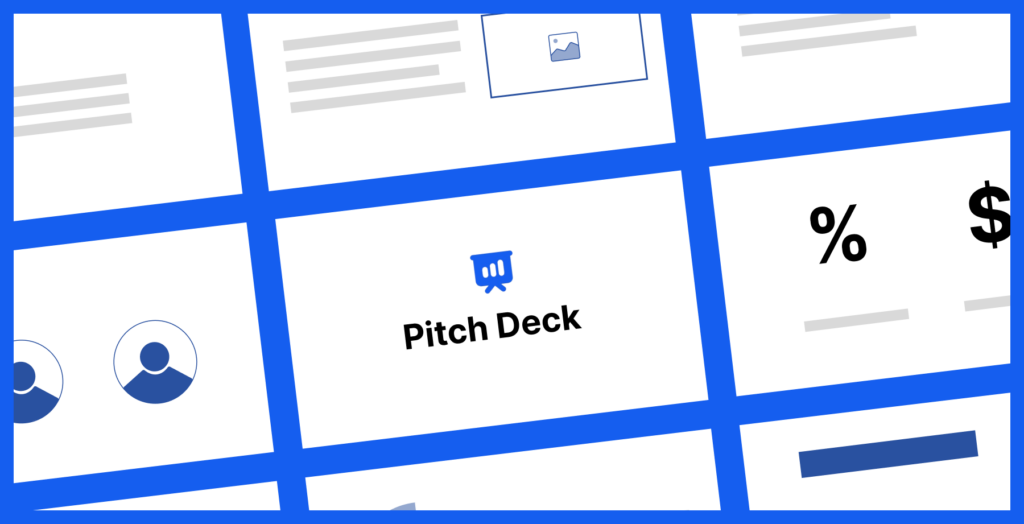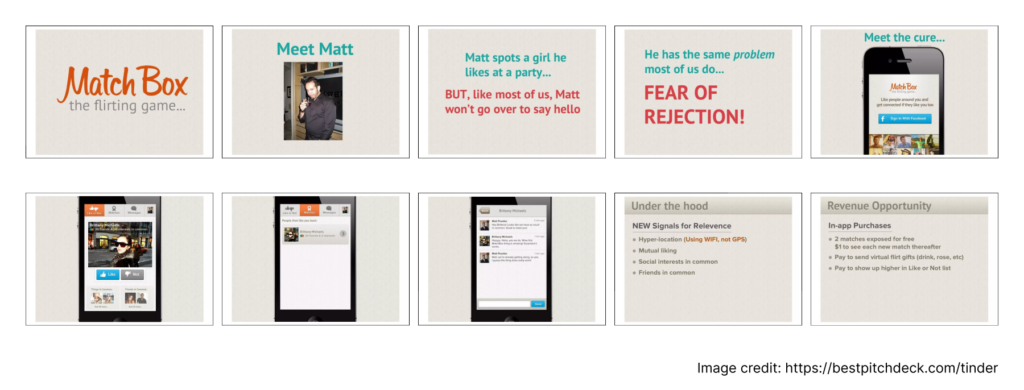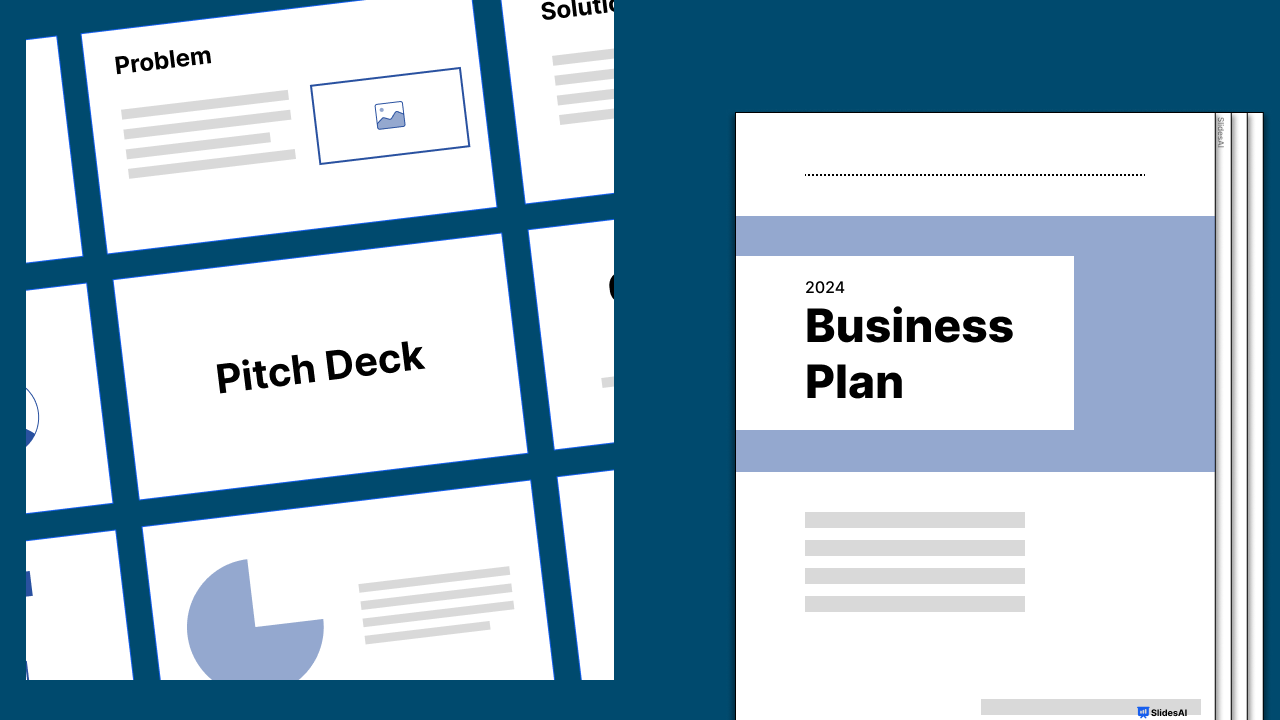Have you ever spent time deciding between creating a pitch deck vs business plan? For startups and new business owners, where every minute counts, it’s crucial to concentrate on activities that deliver the most significant impact.
This blog article demystifies the pitch deck vs business plan, whether you aim to attract investors, secure a loan, or win over partners and clients. We’ll start with pitch decks, followed by business plans, with the goal of helping you choose wisely – so you can spend less time on paperwork and more time building your business.
What is a Pitch Deck?

A pitch deck is a slideshow that concisely conveys your business idea, market opportunity, and value proposition in a presentation format. Also known as a business or investor deck, they are used to quickly present business ideas, products, or services in 10 to 20 slides.
Purpose of a Pitch Deck
The purpose of a pitch deck is similar to that of an elevator pitch: tell a compelling story to grab the attention of potential investors, partners, or clients.
The goal isn’t to seal a deal on the spot but to spark sufficient interest to secure follow-up meetings and negotiate potential funding.
How Long Should a Pitch Deck Be?

Your pitch deck should pack a punch, not bore your investors. Aim for 10-20 impactful slides. For complex ideas or specific industries, slightly more might be okay.
The 10/20/30 rule is your friend: make a 10-slide deck that grabs attention. Investors see hundreds of pitch decks a year. Choose quality over quantity – make each slide count!
💡 Related article: How many slides do you need for a 10-minute presentation?
What Should be in a Pitch Deck?
Most successful pitch decks follow a similar flow to keep investors hooked. The tried-and-tested 10-slide pitch deck format is a great starting point but be prepared to adjust or add slides for emphasis.
These are the 10 core slides for a pitch deck based on Guy Kawasaki’s 10/20/30 rule:
- Problem slide
- Solution slide
- Market size and opportunity
- Product/service
- Business model
- Traction
- Team
- Competition
- Financials and key metrics
- Ask (funding needs)
Here are additional slides you may include based on specific business and investor preferences:
- Introduction
- Go-to-market (GTM) slide
- Vision
- Sales and marketing strategy
- Use of funds
- Exit strategy
💡 Learn more about the 10/20/30 rule: How to create a pitch deck (and the 10 slides you need)
Pitch Deck Examples
Curious how some tech unicorns have pitched their ideas in the early stages? Here are two examples that have proven successful.
✅ Snapchat pitch deck (2013, Pre-seed)

✅ Tinder pitch deck (2016, Seed)

Examples from Best Pitch Decks
What is a Business Plan?

A business plan is a written document with detailed information that acts as a roadmap for your business. A traditional business plan is a formal document that outlines all aspects of your business, including its goals, strategies, market analysis, operational structure, and financial forecasts for the next 3 to 5 years. Most business plans are created in a Word document or report format, ranging from 10 to hundreds of pages long.
There are other types of less formal business plans used by startups or for internal alignment:
- Lean startup plan/Lean canvas: Summarizes the value proposition and business model into a single page, with a focus on the problem-solution fit.
- One-page business plan: Fits the essential information of a business into one page. Great for quickly testing an idea’s viability or getting immediate feedback.
- Internal business plan: Less formal, designed for use within an organization — for example, a feasibility business plan, operations plan, strategic, or expansion plan.
Purpose of a Business Plan
Business plans aren’t just for paperwork – they drive action and results. Think of your business plan as a multi-purpose tool that serves several vital functions:
- Attract investors
- Fundraising or securing loans
- Map your strategy
- Provide a strategic roadmap
- Track business progress or provide a performance benchmark
- Win over partners, talents, and potential hires
Components of a Business Plan
Business plans don’t have a right or wrong format; only different situations call for other formats. You can mix different plan types to prioritize components that directly support your objectives.
What to include in a traditional business plan:
- Executive summary: A concise overview of your entire business plan, highlighting the most critical points.
- Company description: What your business does, the problem it solves, your target market, and competitive advantages.
- Market analysis: Research data like market size, trends, competitors, and customer demographics.
- Organization and management: The business structure, roles, and experience of key team members.
- Products or services: Details on your offer, including features, benefits, pricing, and any intellectual property considerations.
- Sales and marketing strategy: How you plan to reach your target customers (market) and tactics to promote and drive sales.
- Financial projections: Forecasts of your income, expenses, cash flow, and profitability for the next 1 to 5 years.
- Funding request: If you are fundraising, state the amount, how it will be used, and the terms you offer investors.
- Expansion strategy: Outline how you plan to grow into new regions. For remote-first businesses, securing virtual offices and a business address for LLC registration enables low-cost expansion without heavy investment in physical infrastructure.
- Appendix: Include any supplemental information and documents.
💡 Pro tip: Customize your plan! Add, remove, or rearrange sections to achieve your goals.
How Long Should a Business Plan be?

Think about your reader and your goal. Need a detailed plan for a bank loan? That might be 15-25 pages. Want a quick internal roadmap? A one-page Lean Canvas could work. Consider your industry, who’s reading it, and what you need the plan to do.
💡 Pro tip: Choose quality over quantity. Focus on clarity, regardless of length.
How Long Does it take to Write a Business Plan?
It can take anything from 20 minutes to 20 weeks, but tools like an AI business plan generator can speed it up by automating much content creation.. The whole process of creating a business plan can be time-consuming (if opting for a long format), and it can also be quick (for example, the Lean Canvas).
The general advice is: Don’t overthink your first business plan. Start simple, move fast, and build as you grow. Business plans aren’t static, so be prepared to refine and expand your plan as the business evolves.
💡 Pro tip: It’s not uncommon to uncover some challenging sections while writing the plan – the key is to show awareness of these issues and ways to overcome them.
Business Plan Templates
Not sure where to start? Use these example plans and templates from these reputable sources to get you started:
- SBA.gov: Write your business plan – Has the traditional business plan and lean startup business plan templates
- SCORE.org – Has business plan templates for a startup, an established business, and the Business Model Canvas
- Bplans has over 550 business plan examples across multiple industries, which you can use for inspiration.
Create Presentations Easily in Google Slides and PowerPoint
15M+Installs

Pitch Deck vs Business Plan: the Differences
Now that you understand pitch decks and business plans, let’s dive into their key differences.
- Pitch decks are short and punchy, designed to grab investors’ attention and get you that crucial meeting.
- Business plans are thorough and detailed documents, perfect for in-depth analysis or large funding requests.
💡 Think of it this way: Pitch decks are the attention-grabbing movie trailers that sell the whole project. Business plans are your complete blueprint.
| Differences | Pitch Deck | Business Plan |
|---|---|---|
| Purpose | Tell a compelling visual story about the business’s potential. | Provide a comprehensive roadmap of the business’s strategy, operations, and financial projections. |
| Goal | Capture investor interest and secure the subsequent meetings. | Win investor confidence and get funding or investment. |
| Use cases | • Quick presentation to potential investors, partners, or clients • Pitch competitions, startup accelerators • Networking events | • Internal planning and strategy • For securing bank loans or traditional financing • Useful for in-depth discussions with potential investors (after a pitch) |
| Content | Highlights the problem, solution, market opportunity, business model, management team, and financial metrics. | A detailed overview of all aspects of the business, including market analysis, strategy, operations, and financial projections. |
| Level of detail | Concise snapshot. Focuses on storytelling and visual engagement. | Detailed overview of your company. Serves as a roadmap for business development. |
| Length | 10 to 20 slides | 10 to 100+ pages |
| Format | Slideshow presentation style. Usually created with Google Sheets or PowerPoint. | A report or PDF document format created in Word document or Google Docs. |
Both documents can serve you, but understanding their differences helps you select the best tool for attracting investment or charting your company’s path.
Do You Need a Pitch Deck or a Business Plan?
In the past, business plans were the standard document to present a business idea to investors. However, simple business plans and pitch decks are increasingly popular, especially in startups.
Here’s how to choose the right tool for the job:
🎯 Pitches and investor meetings
Pitch decks provide a snapshot of your business or idea’s potential to spark interest and secure future investor meetings.
🎯 Early stages or for idea validation
Use a simple business plan or Lean Canvas, as the format forces you to focus on the core problem you’re solving and the solution.
🎯 Internal roadmap and planning
Formal business plans will aid in longer-term strategic planning, or they can be shorter since they are for internal use.
🎯 Complex business model
Create a thorough business plan with intricate details; short plans and pitch decks wouldn’t cut it for specific industries or complicated business models.
🎯 Fundraising, loans, or traditional financing
Banks, investors, and government-funded grant applications often require a detailed business plan. Whether you seek debt or equity funding, angel investors, VCs, and banks need compelling reasons to support your venture.
💡 Pro tip: You’ll still need a traditional business plan for detailed strategy or significant funding!
Build Stunning Slides in Seconds with AI
- No design skills required
- 3 presentations/month free
- Don't need to learn a new software

Conclusion
Pitch decks and business plans aren’t simply documents – they’re essential tools for driving your business forward. Now that you know the difference, consider your current needs.
Ready to capture investor attention? Start crafting a compelling pitch deck. Need a detailed roadmap? Begin writing a winning business plan. Use the resources in this guide to get started and put your business on the right track toward success!
Frequently Asked Questions
When should you write a business plan?
According to research by Harvard Business Review, between six and 12 months after deciding to start a business. For various reasons, crafting a comprehensive business plan either earlier or later doesn’t necessarily impact business success:
- Most startups pivot from their original ideas and plans.
- The time needed to create a thorough plan is better spent on other business activities (at least initially).
- Creating an elaborate plan may distract entrepreneurs from seeing opportunities in real time and responding to real customers’ needs.
Planning is valuable, and entrepreneurs who plan are more likely to start a successful business. However, you don’t need a complex business plan to begin working on your business. It’s okay to create a plan early on but remember; it’s more about being strategic with your time than trying to forecast the future from the start.
What’s the difference between a business plan and a canvas?
They differ in complexity and length. Business plans are longer and more detailed and are typically used to secure funding from investors or financial institutes.
A canvas, Lean Canvas, or business plan canvas, is a 1-page business plan. The Lean Canvas template helps you deconstruct your idea and focus on finding customer problems worth solving without a significant time investment.
It is popular as a direct replacement for traditional business plans within startups. The canvas can be used for quick and efficient brainstorming of multiple business models in a few hours or less.
How do I turn a business plan into a pitch deck?
Once you’ve done the groundwork of creating a business plan, you can reuse some of the insights, data, and information for a pitch deck.
- First, extract the core details from the business plan, such as the problem you solve, the solution, the size of the market, team strengths, and financials.
- Translate that information into your chosen pitch deck template (for example, the 10-slide pitch deck) or use an AI presentation generator tool such as SlidesAI to structure your slides.
- Add and emphasize visuals. Replace some text with charts, diagrams, and graphs whenever applicable.
- Edit and keep the pitch deck focused and clear. Quality over quantity!
- Get feedback, practice your pitch, and then iterate on the deck until you are ready to show it to investors.
💡 Related article: 5 best free AI pitch deck generators 2024
Is a pitch deck only for investors?
No, while the primary purpose of a pitch deck is to attract funding, it can be adapted for various audiences and goals, such as partnerships, customers (especially enterprise customers), grant applications, startup or pitch competitions, or even for internal alignment within your team.




